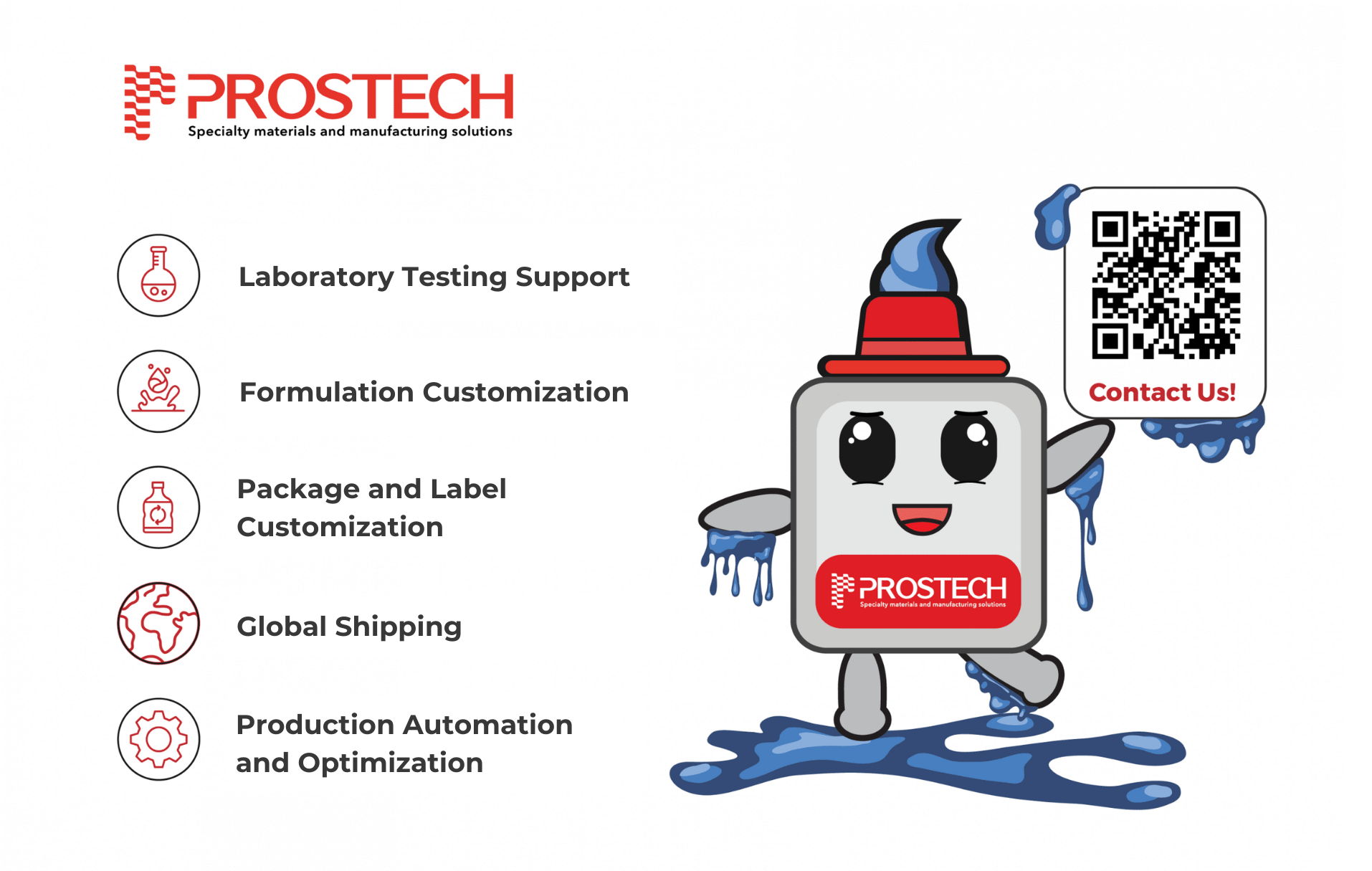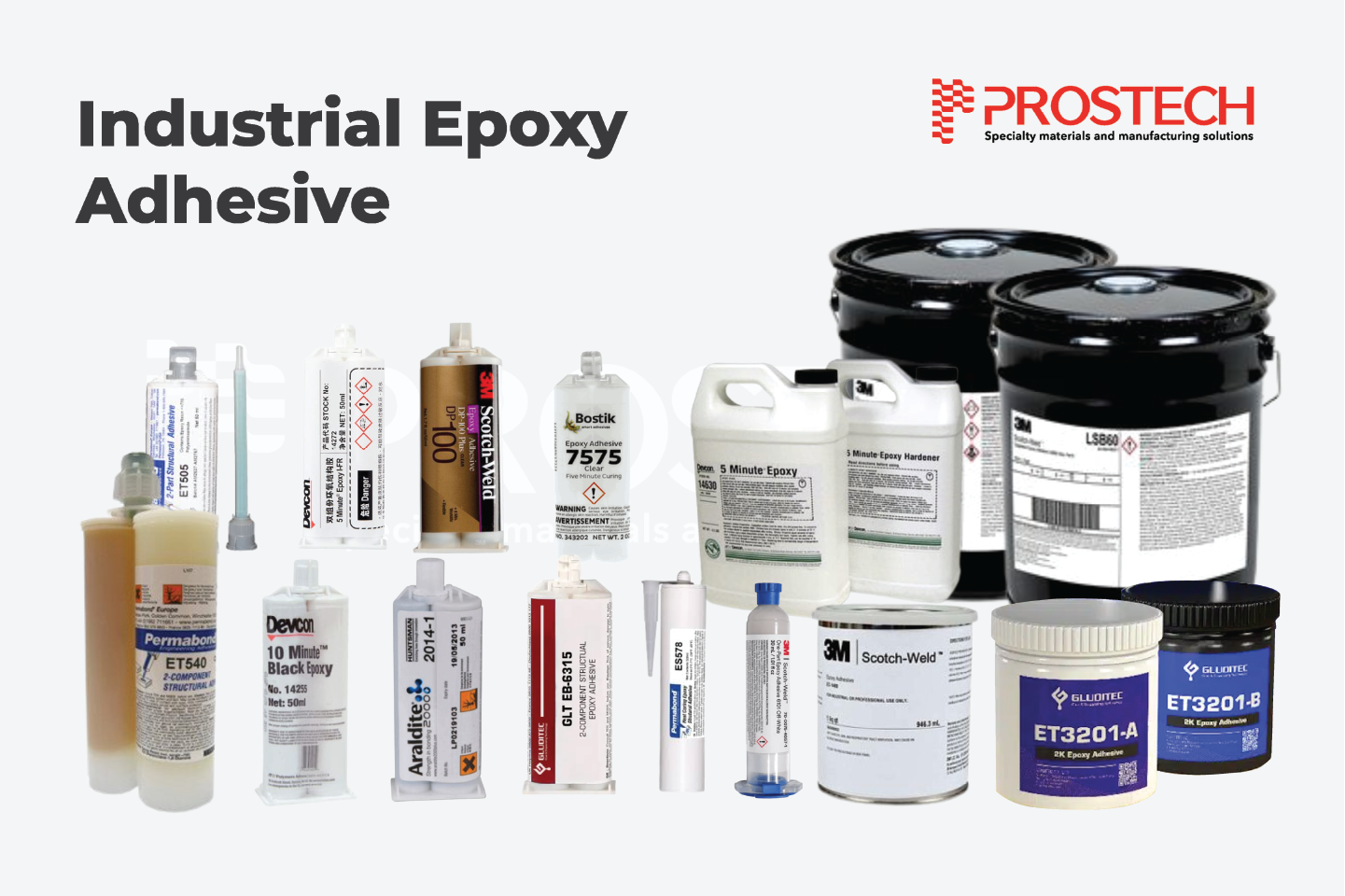Acrylic adhesives are among the most versatile and widely used bonding solutions in the industrial world today. Known for their high strength, fast curing, and ability to bond dissimilar materials, acrylic adhesives are essential across industries such as automotive, electronics, construction, aerospace, and general manufacturing. Whether you’re bonding metals, plastics, composites, or other challenging substrates, acrylic adhesives offer exceptional performance in both structural and non-structural applications.
At Prostech, we are your trusted solution provider for industrial acrylic adhesives. As an authorized distributor for many of the world’s leading adhesive brands—including Plexus, Devcon, 3M, Permabond, H.B. Fuller, Huntsman, Bostik, and others—we provide access to a full spectrum of acrylic adhesive solutions tailored for your specific needs. Whether you need high-strength structural adhesives, UV-curable options, or specialty formulations for difficult substrates, Prostech has you covered.
See all Prostech adhesives here and explore the best adhesive technologies for your business.
What Are Acrylic Adhesives?
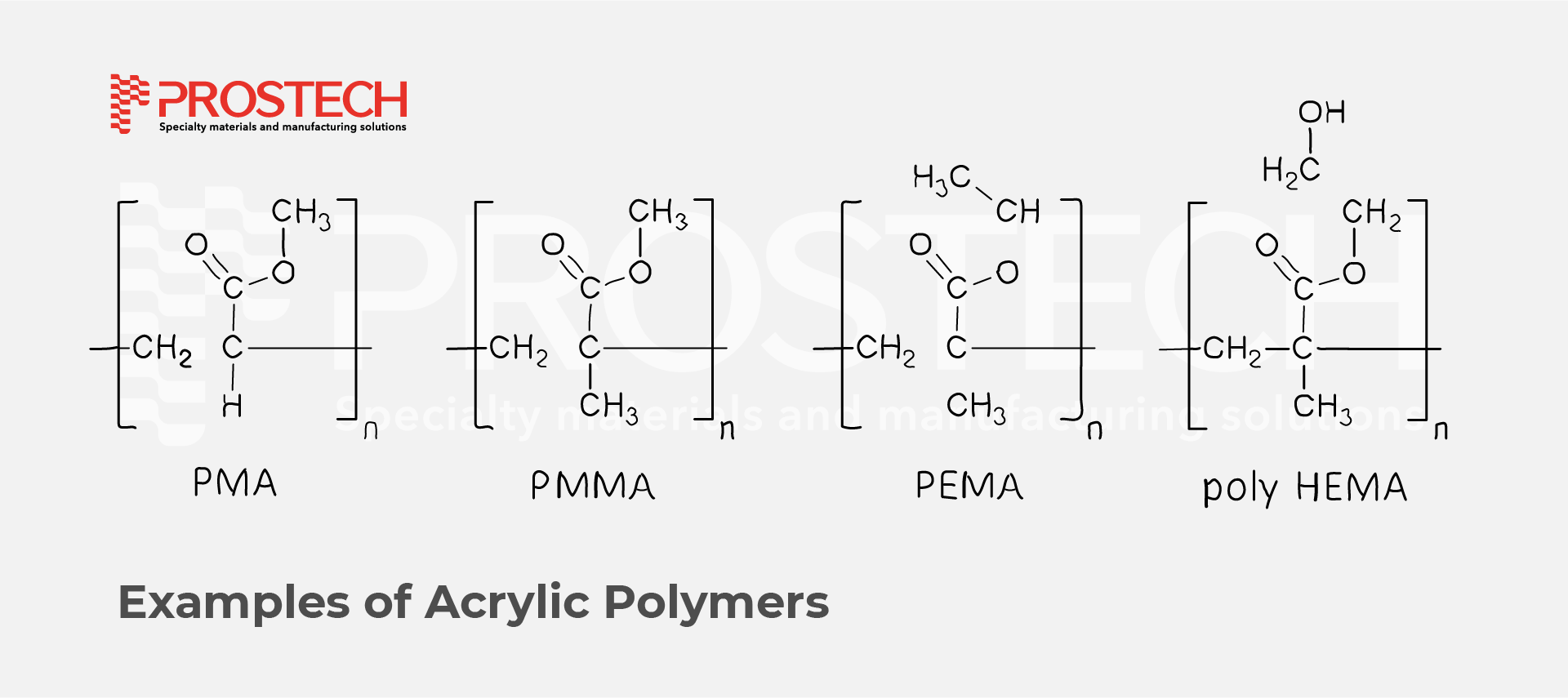
Acrylic adhesives are a class of adhesives formulated from acrylic polymers, including acrylic acid, methacrylic acid, and their derivatives. These adhesives are widely recognized for their excellent durability, high strength, and exceptional versatility across a broad range of industrial and commercial applications.
Structurally, acrylic adhesives are typically based on methyl methacrylate (MMA) or related monomers, and they are available in several distinct formulations.
These adhesives function through various curing mechanisms—such as free-radical polymerization or UV-induced crosslinking—allowing them to bond effectively to a wide variety of substrates, including metals, plastics, composites, ceramics, glass, and wood.
Methylmethacrylate Adhesive (MMA)
Types of Acrylic Adhesives
Acrylic adhesives are available in a variety of formulations, each designed to meet specific performance, process, and application needs. Selecting the right type depends on factors such as substrate materials, required bond strength, curing speed, environmental conditions, and processing methods.
Below is an in-depth guide to the most common types of acrylic adhesives used across industries:
1. Structural Acrylic Adhesives
Structural acrylic adhesives are high-performance adhesives engineered for load-bearing and demanding structural applications. They are typically two-component systems that cure through chemical reactions, often using free-radical polymerization. These adhesives are known for:
-
High tensile, shear, and peel strength
-
Fast curing at room temperature
-
Excellent impact and fatigue resistance
-
Ability to bond dissimilar materials, including metals, plastics, and composites
-
Minimal surface preparation requirements (even bonds oily or slightly contaminated surfaces)
Common Chemistries within Structural Acrylics:
-
Methyl Methacrylate Adhesives (MMA): Extremely strong and tough; good for metals and composites but often have strong odor and flammability.
-
Low Odor Acrylics: Less odor and safer handling, ideal for plastics and general assembly applications.
-
Low Surface Energy (LSE) Acrylics: Specifically designed to bond difficult plastics like polypropylene, polyethylene, and thermoplastic olefins (TPO) without surface treatment
Prostech Recommend Structural Acrylic Adhesives:
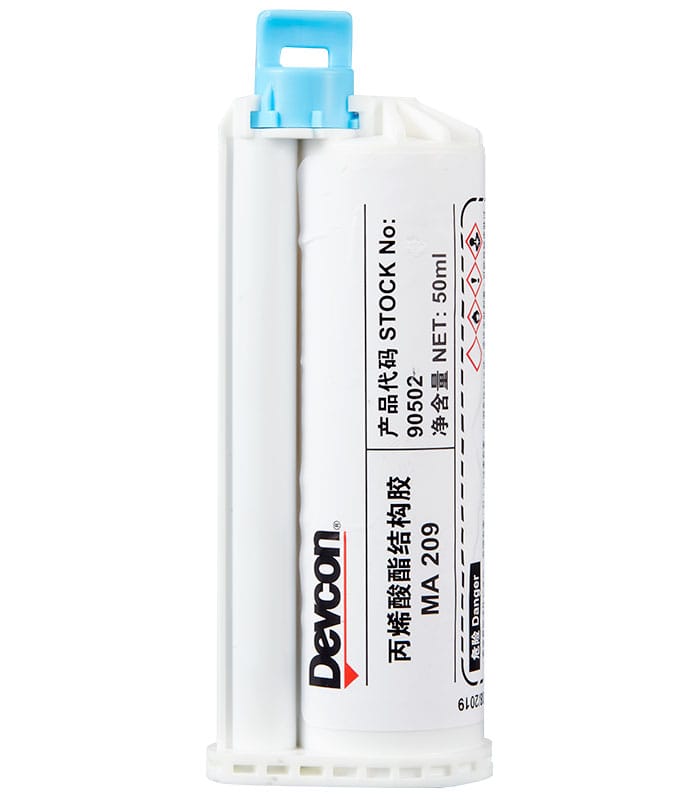
- Plexus® MA8110/GB Two-part Methacrylate Adhesive
- PERMABOND® TA4631 Toughened Acrylic Adhesive
- ARALDITE 2053 – 05/15 Two-component acrylic adhesives
- Two component toughened methacrylate adhesive system Araldite 2021-1
- 3M Scotch-Weld Acrylic Adhesive DP820
- 3M™ Scotch-Weld™ Low Odor Acrylic Adhesive DP810
Prostech specializes in high-performance structural adhesives designed for demanding bonding applications that require exceptional strength, durability, and reliability. Whether you need adhesives for metals, composites, plastics, or dissimilar material bonding, we provide the right solution for your industry.
Industrial Structural Adhesives
2. UV-Curable Acrylic Adhesives
UV-curable acrylic adhesives are formulated to cure rapidly upon exposure to ultraviolet (UV) or visible light. They offer “cure-on-demand” processing, making them ideal for high-speed production lines where precision and fast throughput are essential.
Key Features:
-
Fast curing in seconds when exposed to UV light
-
Excellent clarity after cure (non-yellowing)
-
Low shrinkage and high impact resistance
-
Gap-filling capability with minimal exothermic reaction
-
Multi-substrate adhesion, including metals, glass, and plastics like ABS and PMMA
-
Typical applications include electronics assembly, luxury goods, optical components, and medical devices.
Recommended UV-Curable Acrylic Adhesives:
At Prostech, we offer comprehensive manufacturing solutions—including advanced UV-curing acrylic adhesives for high-speed, high-precision production lines.
See our Fast Cure UV Acrylics products here. Or contact Prostech for expert consultation and customized adhesive solutions for your production processes!
To know more about UV Adhesive, please visit our Blog:
What is UV Adhesive? Applications of UV Adhesive in Automotive Industry
UV Dual Cure Adhesive: Secondary Curing Mechanisms of UV Adhesives
UV Adhesive – A Comprehensive Overview
UV Adhesive: A guide to overcome all the challenges for optimizing its benefits
3. Solvent-Based Acrylic Adhesives
Solvent-based acrylic adhesives are formulated by dissolving acrylic polymers in organic solvents. These adhesives are typically used for:
- Conformal Coating: thin film layer for PCB protection
-
Laminating films, foils, and packaging materials
-
Applications requiring excellent solvent, chemical, and UV resistance
-
Thin bonding layers in flexible assemblies
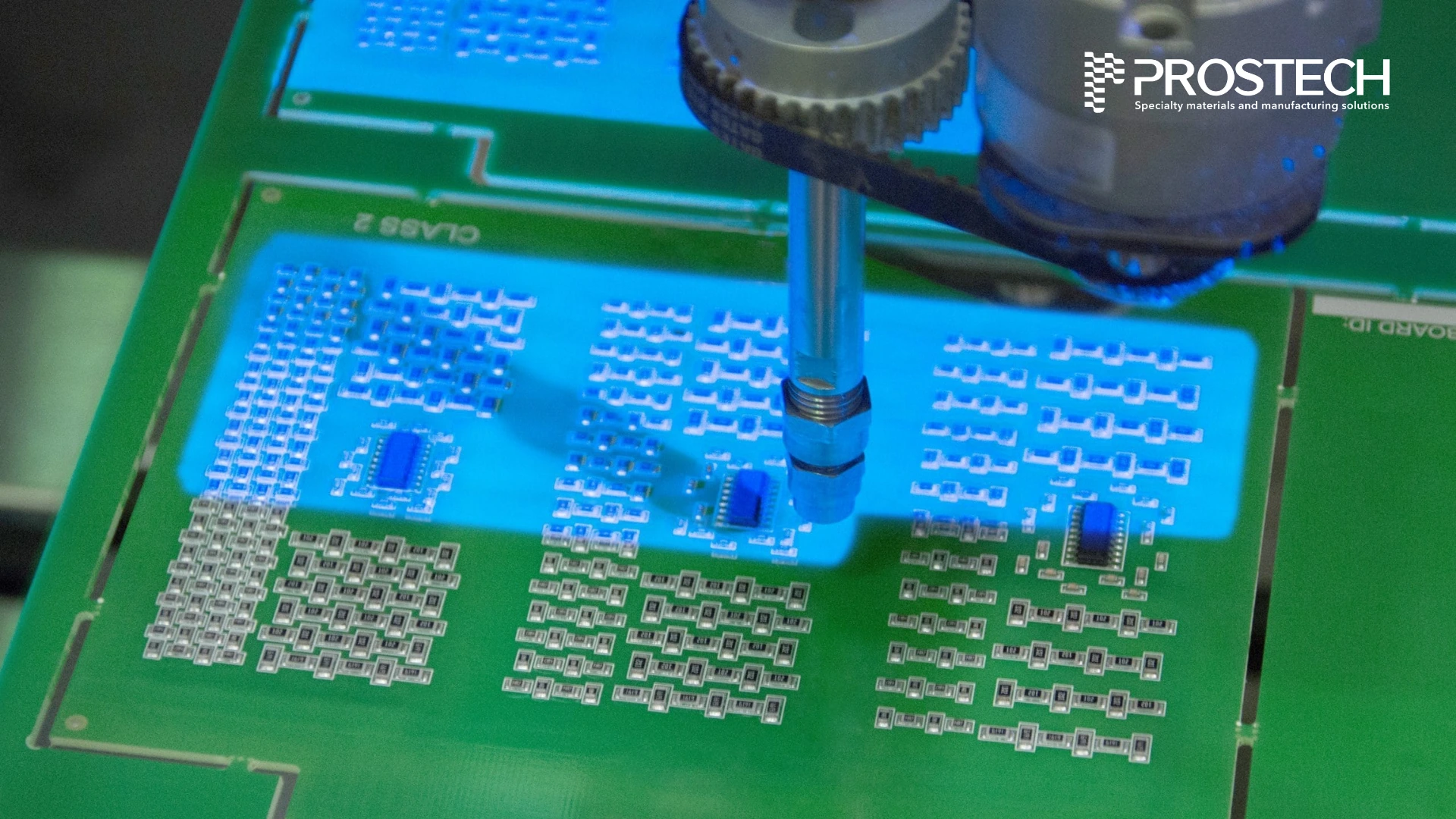
They offer long open times and can be applied by spray, brush, or roller. However, they may require ventilation and compliance with environmental regulations due to solvent emissions.
Recommended Solvent-Based Acrylic Adhesives:
- ELPEGUARD SL 1307 FLZ-T Conformal Coating
- Peters ELPEGUARD® SL 1347 Acrylic conformal coating
- Techspray 2108 Turbo-Coat Acrylic Conformal Coating
- Turbo-Coat HV Acrylic Conformal Coating 2109-P
- Fine-L-Kote AR Acrylic Conformal Coating 2103-12S
Prostech is an authorized distributor of high-quality Acrylic Conformal Coating solutions, designed to protect electronic assemblies against moisture, dust, chemicals, and temperature extremes.
Contact Prostech today for expert consultation and product recommendations tailored to your specific application needs!
4. Thermosetting Acrylic Adhesives
Thermosetting acrylic adhesives are specialized formulations that provide:
-
Exceptional toughness and flexibility
-
High peel and impact resistance
-
Fast curing at room temperature, with some systems curing in minutes
-
Excellent chemical resistance and fatigue durability
These adhesives cure via free-radical polymerization and are often used in marine, transportation, and sports equipment industries for bonding composites, metals, and plastics—even on oily surfaces.
Recommended Thermosetting Acrylic Adhesives:
Toyobo Thermosetting TYPE VYLOSHOT™
Quick Comparison Table
| Type | Curing | Key Strengths | Typical Applications |
|---|---|---|---|
| Structural Acrylics | Room temperature (fast) | High strength, impact resistance, bonds dissimilar materials | Automotive, aerospace, construction |
| UV-Curable Acrylics | UV/Visible Light | Cure-on-demand, transparent, high precision | Electronics, optical devices, luxury goods |
| Solvent-Based Acrylics | Solvent evaporation | Chemical resistance, flexible bonding | Packaging, laminating films, coatings |
| Thermosetting Acrylics | Room temperature | Toughness, high fatigue resistance, bonds oily surfaces | Marine, sports gear, heavy-duty equipment |
At Prostech, we proudly supply the full range of acrylic adhesives mentioned above—including structural, UV-curable, solvent-based, and thermosetting acrylic adhesives—from leading global manufacturers like Plexus, Devcon, 3M, Permabond, H.B. Fuller, Huntsman, Bostik and more.
Our technical experts are ready to consult and help you select the most suitable adhesive for your specific materials, processes, and performance requirements.
Contact Prostech today for expert consultation and tailored adhesive recommendations.
Or, if you’d like to explore further, read our in-depth article here:
Acrylic Adhesives Uses In Industrial Manufacturing
We are ready to support your projects—from product selection to implementation!
Key Properties of Acrylic Adhesives
Understanding the key properties and performance metrics of acrylic adhesives is essential for selecting the right adhesive for industrial bonding applications. Acrylic adhesives are widely valued for their unique combination of strength, speed, flexibility, and environmental resistance, making them ideal for demanding industries such as automotive, aerospace, construction, electronics, and general manufacturing. Below are the most critical performance of acrylic adhesives:
1. High Bond Strength: Tensile, Shear, and Peel Strength
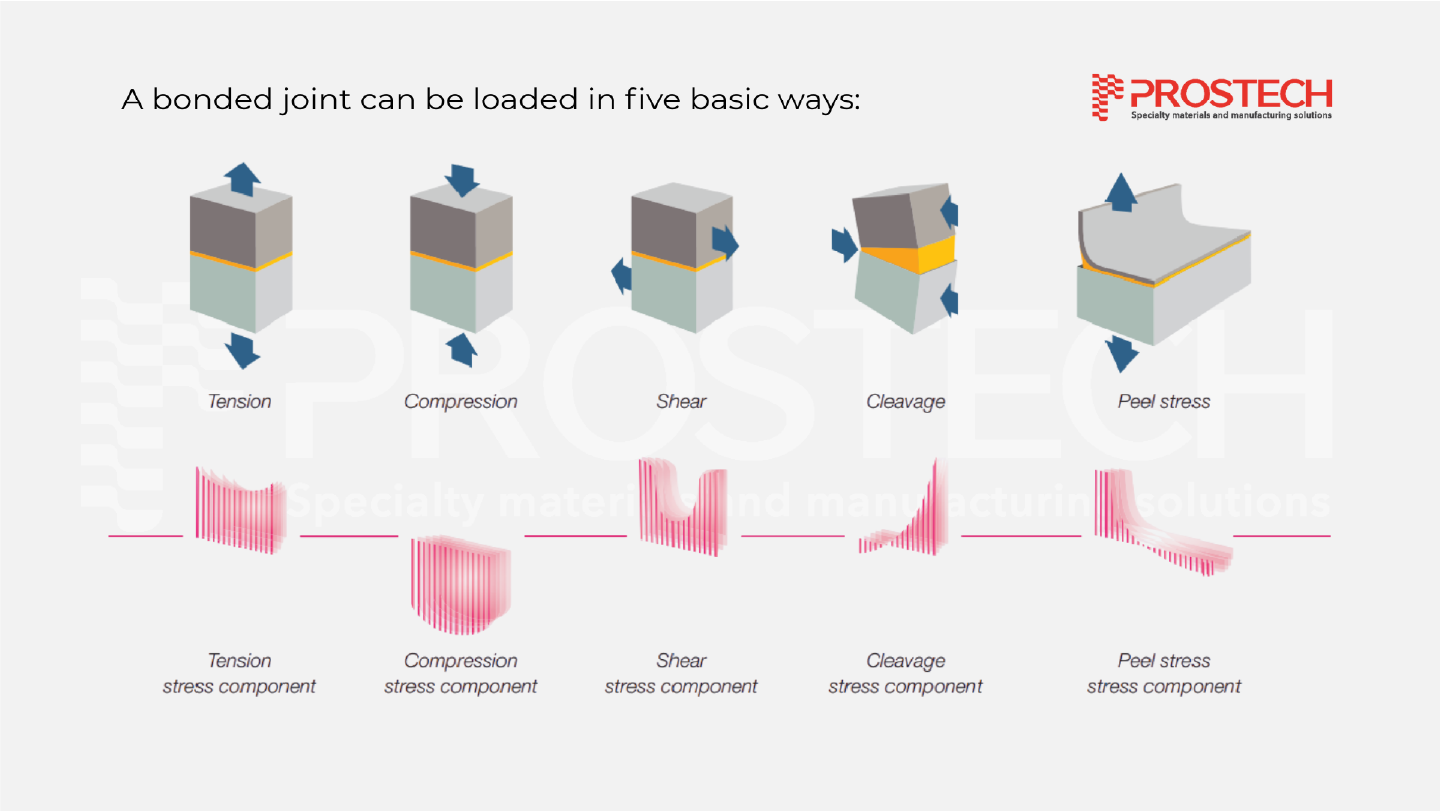
Tensile Strength
Tensile strength measures the adhesive’s ability to resist pulling forces that attempt to stretch or pull apart the bonded materials.
Key Highlights:
-
High tensile strength is essential for structural applications where static or dynamic tensile forces are expected.
-
Tensile strength is especially critical in load-bearing assemblies such as frames, panels, and load transfer joints.
Shear Strength
Shear strength refers to the adhesive’s ability to withstand forces that try to slide one bonded surface over another.
Key Highlights:
-
Essential for most industrial joints subjected to lateral loads, such as panel bonds, metal brackets, and vehicle parts.
-
Many acrylic adhesives outperform mechanical fasteners in shear strength while distributing load more evenly.
-
Commonly 2,000 to 5,100 psi (14–35 MPa)
Peel Strength
Peel strength measures the adhesive’s ability to resist forces that attempt to peel apart the bonded substrates along a thin edge or corner.
Key Highlights:
-
Critical for flexible joints and assemblies exposed to impact or dynamic forces, such as composites and plastics in automotive or sporting goods.
-
High peel strength indicates good toughness and energy absorption.
Selecting the right acrylic adhesive starts with a thorough understanding of its key properties and performance metrics. Acrylic adhesives offer a rare combination of high bond strength, fast curing speed, flexibility, and outstanding environmental resistance, making them highly suitable for demanding industries such as automotive, aerospace, electronics, construction, and manufacturing.
By carefully evaluating critical factors such as tensile strength, shear strength, and peel resistance, manufacturers can identify adhesives that not only meet structural performance needs but also improve production efficiency and product reliability.
Whether you need adhesives for load-bearing frames, panels, vehicle parts, or dynamic joints in sectors like automotive, aerospace, electronics, or construction, our experts are ready to help you choose the ideal solution.Contact Prostech today for professional consultation, product recommendations, and high-strength adhesive bonding solutions tailored to your needs!
2. Fast Cure & Optimal Working Time
Cure Speed refers to how quickly an adhesive develops usable strength after mixing or activation. Working Time refers to the amount of time available to apply and position parts before the adhesive begins curing.
-
Acrylic adhesives generally offer faster cure times than epoxies and urethanes.
-
Some formulations provide handling strength in minutes or even seconds.
-
UV-curable acrylics cure instantly under UV light, allowing “cure on demand” processing.
-
Working times can vary from a few seconds to over 30 minutes, depending on the product.
3. Ability to bond a wide range of substrates
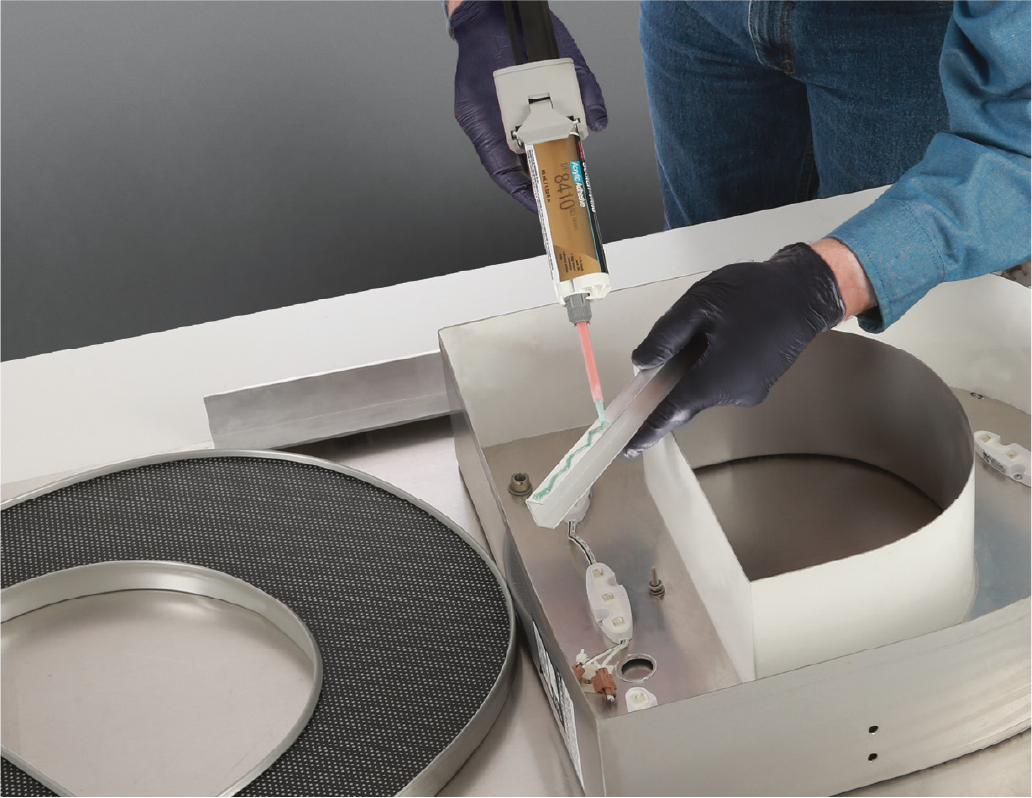
One of the biggest advantages of acrylic adhesives is their ability to bond a wide range of substrates, often outperforming other adhesives in multi-material assemblies.
-
Excellent for bonding metals, plastics, composites, ceramics, and even some difficult substrates.
-
Many acrylics tolerate oily or lightly contaminated surfaces, reducing surface prep needs.
-
Specialized formulations can bond low surface energy (LSE) plastics like polyethylene (PE), polypropylene (PP), and TPO.
Common Substrates for Acrylic Adhesives:
-
Metals: Aluminum, stainless steel, galvanized steel, carbon steel.
-
Plastics: ABS, PMMA, polycarbonate, nylon, and more.
-
Composites: FRP, carbon fiber composites, epoxy laminates.
-
Dissimilar Materials: Metal-to-plastic, plastic-to-composite, or metal-to-composite joints.
Read more:
Mastering Adhesive Solutions for Tricky Surfaces: Polyolefin and Teflon
How to bond Hard-to-bond Substrates (Nylon, COC/COP and PEBA) in Medical Devices Assembly?
The best adhesive to bond plastic to metal
4. Durability & Environmental Resistance
Acrylic adhesives are well-regarded for their long-term performance in harsh environments and under mechanical stresses.
-
Excellent resistance to moisture, temperature extremes, vibration, and fatigue.
-
Most structural acrylics withstand continuous use up to 120°C (248°F); some advanced products handle up to 175°C (347°F).
-
Maintain strength after exposure to humidity, UV, fuels, and mild chemicals.
-
Some formulations retain over 90% of bond strength after prolonged environmental testing.
5. Gap-Filling & Flexibility
Many acrylic adhesives provide excellent gap-filling capabilities and retain toughness after cure, making them ideal for uneven or irregular surfaces.
-
Fill gaps from 0.25 mm up to 2.5 mm or more depending on formulation
-
Maintain flexibility after curing to absorb shock, vibration, and mechanical stresses.
-
Toughened grades combine impact resistance with flexibility, reducing joint failure risks.
No matter your industry or application, there is a suitable acrylic adhesive that matches your requirements.
Need help selecting the right adhesive?
Contact Prostech for expert recommendations on the best acrylic adhesive for your specific materials and production needs.
How to Select the Right Acrylic Adhesive
Choosing the right acrylic adhesive for your application is essential to ensure optimal performance, production efficiency, and long-term durability. With the wide variety of acrylic adhesive technologies available—ranging from structural acrylics to UV-curable adhesives—it’s important to evaluate your project’s specific requirements carefully.
Here’s a step-by-step guide to selecting the best acrylic adhesive for your needs:
Step 1: Identify Your Substrates
The first and most important question is: what materials are you bonding? Acrylic adhesives are known for their versatility, but different formulations are optimized for specific substrates.
Metals: Most acrylics bond well to common metals like aluminum, steel, and even coated metals like E-coat and powder-coated surfaces. They are also an excellent choice for bonding dissimilar metals (e.g., stainless steel to aluminum), as they can help prevent galvanic corrosion by isolating the joints.
Plastics: One of the greatest strengths of acrylics is their ability to bond a wide variety of plastics, including ABS, polycarbonate (PC), and PVC. This is a key advantage they hold over many epoxy adhesives.
Low Surface Energy (LSE) Plastics: If you are working with notoriously difficult-to-bond plastics like polypropylene (PP), polyethylene (PE), or thermoplastic olefins (TPO), look for an LSE-specific acrylic adhesive. These specialized formulations can create strong, structural bonds without the need for primers or other intensive surface treatments.
Composites: Acrylic adhesives are widely used to bond composites such as carbon fiber, fiberglass reinforced plastic (FRP), and glass reinforced plastic (GRP).
Surface Condition: A significant benefit of acrylics is their tolerance for surface contamination. They can often achieve strong bonds on metals with minimal surface preparation, including those with light surface oils or dust. While cleaning is always recommended, this forgiving nature makes acrylics robust for real-world production environments.
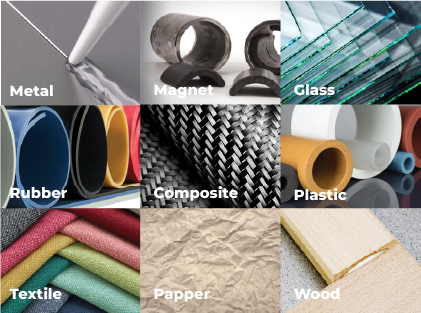
Step 2: Define Your Process Requirements
How the adhesive fits into your production line is just as important as its final strength. Consider these manufacturing variables.
Cure Time: This is a critical factor for production speed.
Working Time (Open Time): This is the amount of time you have after mixing to apply the adhesive, mate the parts, and get them clamped or fixtured. Large, complex assemblies may require an adhesive with a longer working time.
Fixture Time (Handling Time): This is the time it takes for the bond to become strong enough (often measured at 100 PSI) to be moved to the next step in the production process without damaging the bond. A fast fixture time is key to achieving high output and reducing bottlenecks.
Viscosity: Viscosity refers to how thick or “runny” the adhesive is.
Low Viscosity (Liquid): A thinner, more liquid adhesive is ideal for applications with tight tolerances or for covering a wide surface area quickly.
High Viscosity (Paste): A thicker, paste-like adhesive is essential for vertical or overhead applications, as it will not sag or drip during application or curing.
Gap Fill: You must consider the size of the gap between your substrates. While some surface-activated acrylics perform best in very thin bond lines, many two-component mixed products are capable of filling large gaps. Some formulations even contain microscopic glass spacer beads to ensure a consistent bond line thickness across the part.
Step 3: Consider the End-Use Environment
Finally, evaluate the conditions the bonded part will face throughout its service life.
Temperature Exposure: What are the highest and lowest temperatures the bond will experience? While traditional acrylics typically have a lower continuous service temperature than high-performance epoxies, next-generation acrylics offer improved heat resistance.
Environmental & Chemical Resistance: Will the product be used outdoors or exposed to moisture, humidity, industrial chemicals, or solvents? Acrylic adhesives generally have good moisture and outdoor weather resistance. However, they may have limited resistance to certain polar solvents or strongly acidic solutions, so it’s important to match the formulation to the expected exposure.
Mechanical Stresses: Will the bond be subjected to static loads or dynamic forces? Toughened acrylic adhesives are specifically designed with high impact and peel resistance to absorb energy from shock, vibration, and peel forces, ensuring the bond remains durable and reliable in demanding applications.
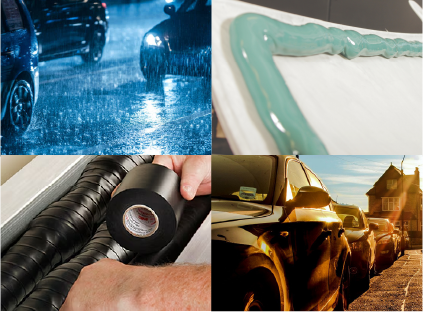
Common Mistakes to Avoid
-
Ignoring Surface Prep: While acrylic adhesives tolerate some surface contamination, proper cleaning improves results.
-
Overlooking Cure Profile: Ensure cure time aligns with production flow.
-
Not Considering Temperature or Chemical Exposure: Some adhesives degrade under harsh conditions—choose carefully.
Finding the perfect acrylic adhesive can be complex—but you don’t have to do it alone.
At Prostech, we specialize in providing technical consultations and adhesive solutions for a wide range of industries. Whether you need UV-curable adhesives, structural acrylics, or specialty formulations for difficult substrates, our experts can help you identify the best product for your application.
Contact Prostech today for product selection advices
Practical Applications of Acrylic Adhesives
Acrylic adhesives are widely used across various industries due to their exceptional versatility, strength, and durability.
In the automotive and transportation sectors, they are applied for bonding body panels, structural components, composite parts, and even in electric vehicle battery assemblies, where high impact and vibration resistance are crucial.
In the electronics and electrical industries, UV-curable acrylics are commonly used for PCB encapsulation, component bonding, and optical devices requiring precise, transparent adhesion.
The construction and infrastructure sectors benefit from acrylic adhesives for window assemblies, architectural panels, flooring, and façade installations, thanks to their weather resistance and strong bonding to metals, glass, and plastics.
Acrylic adhesives are also prevalent in marine, aerospace, and sporting goods manufacturing for assembling composites, lightweight materials, and safety-critical parts.
Additionally, they are essential in luxury goods packaging, appliances, and medical devices, where aesthetic finishes and structural integrity are equally important.
Their ability to bond dissimilar materials with minimal surface preparation makes them indispensable for modern, multi-material designs across these industries.
Contact Prostech today for expert consultation, product selection, and customized adhesive solutions that meet your industry’s exact needs!
FAQs about Acrylic Adhesives
1. Are acrylic adhesives stronger than epoxy adhesives?
Acrylic adhesives offer excellent strength, often comparable to or even exceeding epoxies in certain applications, especially for bonding metals, plastics, and composites. While epoxies typically provide higher temperature resistance and long-term durability in harsh chemical environments, acrylic adhesives offer faster curing, better flexibility, and superior bonding to low surface energy plastics and oily surfaces. They also generally require less surface preparation than epoxies.
2. Can acrylic adhesives bond dissimilar materials?
Yes, acrylic adhesives are specifically designed to bond a wide variety of dissimilar materials, including metals, plastics, composites, and coated surfaces. Specialized formulations can even bond difficult substrates like polypropylene (PP) and polyethylene (PE) without the need for primers.
3. How fast do acrylic adhesives cure?
Cure time varies depending on the adhesive type. UV-curable acrylic adhesives can cure within seconds under UV light, while structural acrylic adhesives typically develop handling strength within minutes to a few hours. Many formulations provide “snap cure” performance, allowing for high production speeds.
4. Are acrylic adhesives resistant to environmental conditions?
Yes, most acrylic adhesives offer excellent resistance to moisture, weathering, and fatigue. Many formulations maintain their bond strength after prolonged exposure to high humidity, thermal cycling, or chemicals, making them suitable for both indoor and outdoor applications.
5. Can acrylic adhesives fill gaps between parts?
Absolutely. Many acrylic adhesives have excellent gap-filling properties, allowing them to bridge gaps from 0.25 mm up to 2.5 mm or more, depending on the formulation. They can also maintain flexibility and impact resistance even with thicker bond lines.
6. How long do acrylic adhesives last?
Acrylic adhesives offer long-term durability and can last for many years in service when applied correctly. Shelf life typically ranges from 6 to 18 months, depending on the product type and storage conditions. Once cured, many acrylic adhesives maintain structural integrity for the lifetime of the product.
7. Are acrylic adhesives safe to use?
Modern acrylic adhesives are designed with user safety in mind. Many formulations are low odor and non-flammable. However, proper ventilation, personal protective equipment (PPE), and adherence to product safety guidelines are always recommended, especially during mixing and application.
Prostech proudly supplies a full range of industrial acrylic adhesives, from high-performance Structural Acrylic Adhesives (MMA) to fast-curing UV Acrylic Adhesives, serving diverse industries such as automotive, electronics, construction, and manufacturing.
We don’t just sell adhesives — we provide complete bonding solutions:
-
Expert product consultation tailored to your specific application
-
Laboratory compatibility testing with your sample materials
-
Global shipping and delivery to meet your production timeline
-
Automation process support to optimize adhesive dispensing and application in your factory
Contact Prostech today to receive professional advice and unlock the full potential of advanced acrylic adhesives for your business.
